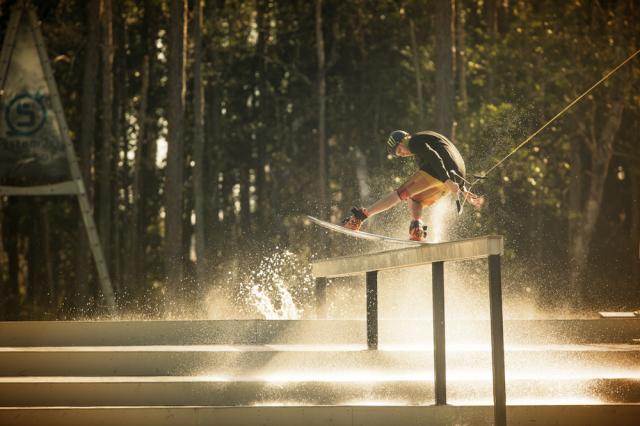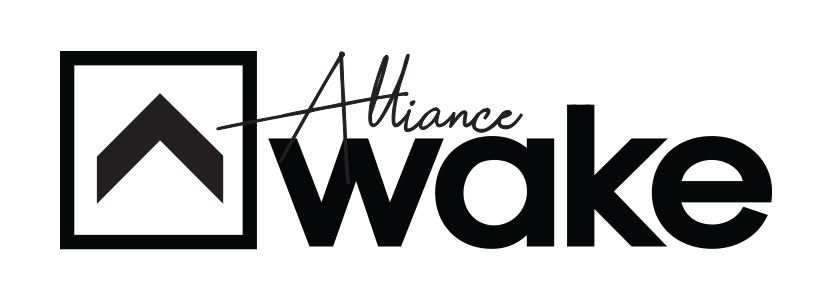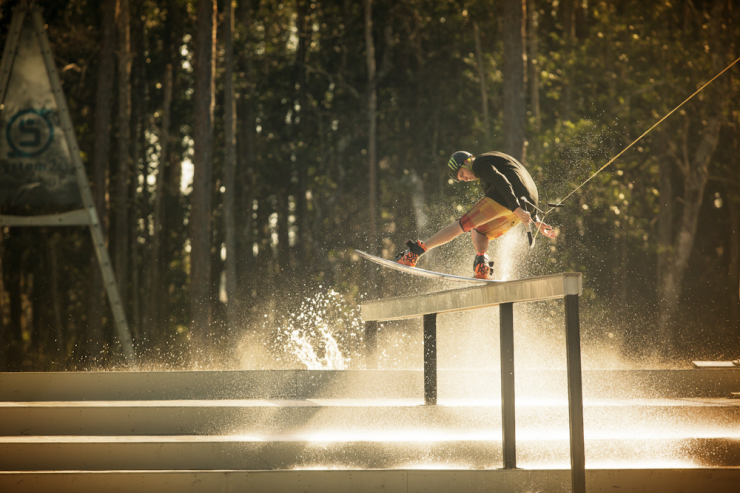No Filter – Kevin Henshaw

Henshaw has built his field of dreams, the question is how long until the industry catches on. Photo: Soderlind
Alliance: Is Area 52 everything you imagined it to be?
Kevin Henshaw: Yeah, definitely. Every time I go out there it seems like my jaw drops and a dream come true. I wanted to build it because wakeboarding was getting a little stagnant for me. Cable parks can get pretty repetitive because they can’t change out rails very much, and the Projects hasn’t really been in operation for a while, so there wasn’t a place where I could do what I really love to do, which is build and create things. I figured if snowboarders and skateboarders can have their own warehouses and private riding parks and stuff that wakeboarders could, too and we’d seen it some with spots like Shredtown and Battle Falls why couldn’t I build one?
A: What do you make of some of the flak and trolling that’s going down online about Area 52?
KH: I think people need to remember I’m doing this for the sport, not myself. Whether I’m riding there or somebody else is riding there, if somebody watching online is that upset about it why not build your own? Show everybody else that you can handle the logistics of a project like that. Then you do what you want and say what you want. Area 52 took everything I had financially and sometimes mentally and physically to put together. It got scary at times where I had almost no money in the bank and was wondering what the hell I’m doing. I think people like that who just say shit don’t understand how gnarly something like this, both in terms of lifestyle and riding. I don’t let the talk get to me, but I would love to see somebody else who thinks it isn’t legit do it on their own. (laughs) Everybody is entitled to their own opinion, I know I’ve got mine.
A: Building it meant taking time away from being a rider. How did that impact your career?
KH: Taking that amount of time away from riding and just focusing on building the park was a tough decision, I ended up getting myself in a little trouble for it and I think I’m still paying for it. But now that the park is built and people are seeing it and what’s possible there, they’re understanding more and more why I spent so much time doing it. My riding took a hit too though. I basically took a year off from riding regularly and it’s taking me a while to get some stuff back. It’s shown me how quickly wakeboarding is progressing. When I started working on the park I felt like I was on my game and was on point with everybody, but now I feel like I’ve got some catching up to do. I think in the long run it’s going to be worth it. I’m riding three times a day now and loving it, and my mind is going crazy thinking of things to build.
A: What is your long term goal for Area 52 and what would you be doing if you hadn’t built it?
KH: I don’t know what’d I’d be doing! (laughs) I guess I’d just be doing the same thing just riding. I don’t think I’d be as involved in the sport, that’s for sure. Having guys come out to ride and talking to lots of people about the park has kept me more involved. And now I feel like I have something to prove to show people that the place is worth it so that kids in the future can go to sponsors and have them build this stuff for them. That’s the long term goal. This whole thing really comes down to what I want the future of wakeboarding to be like and I want kids to have places like this in their backyards. I want wakeboarding to get bigger and gnarlier and I think parks like this are the way to go. There is only so much you can do at a regular cable park because of insurance and liability and stuff, so places like mine and Lake Ronix and Jibtopia are where you’re going to see some crazy progression go down. I think that’s the future.
A: What are you going to do in 2015 to stay relevant?
KH: Just ride my ass off and build some things that nobody has done before. I want to do another big web edit and drop a bomb on everybody at Surf Expo. (laughs) Winning the Web Video of the Year award from Alliance a couple years ago was one of the best things that’s ever happened for me in my career, hands down. I put so much time into riding and building that, so it was my biggest accomplishment. Seeing the reactions to it was amazing, so that’s my focus again this year now that the park is built. Obviously I’ll do little videos here and there throughout the year, but I want to work on two big pieces: one focused on riding and another focused on the making of Area 52.
A: What has you stoked about wakeboarding right now?
KH: There are a lot of things I’m pumped on right now, but there are also some aspects I’m not pumped on, too. I’m pumped on the direction of park riding, especially with more guys pushing what’s possible that way. Guys are doing things on their wakeboards now that nobody had even thought of just a few years ago.
A: What bothers you about wakeboarding right now?
KH: All the shittalking, for one. There’s so much beef in the industry it’s insane. I’m not saying I’ve never said anything everybody does, it’s part of any sport but we would be a lot better off to be more supportive of each other as pros. Another thing I think is a huge problem in our sport is guys riding for sponsors for free or just some product. If you get some free product and you want to plug somebody on a social media post or something, cool. But don’t slap a sticker on your board and act like you’re sponsored. At that point they’re just using you for free exposure for their brand. As a pro wakeboarder you are a business and your board is like a billboard and you can’t make a living on getting free stuff. I won’t put a sticker from a brand on my board unless I’m getting paid. I feel like a lot of the younger guys are giving up too much too soon and trying to look like they’re pros, but really they’re just riding for free and making the industry harder for everybody else. If you want to be pro sometimes that means saying no to a bad deal, or riding for a smaller company at first. They might not have the clout of a bigger brand, but at least they can offer you something. I think this is a problem younger riders have always had because they want to feel like they’ve made it, or they want to look like they have connections to cool, wellknown brands, but recently I’ve even seen some of the guys my age doing it. I understand wanting to hold on to something, but free is free. Don’t give those companies the opportunity to look at our sport like that. The second you do that it just makes the problem worse because then that company figures they don’t need to put money into our sport, they can just find somebody to ride for free. Wakeboarding will die as long as riders keep doing that because eventually companies will put less and less money toward legitimately sponsoring pro riders. Without pro riders making a living as pro riders, a sport can’t exist it just becomes a hobby. I think sometimes these companies forget how beneficial sponsoring a legit rider can be, there really are kids out there who look up to individual guys and want to ride like them and have the gear that they have. That’s where being a pro comes into play, and that’s the value of putting a sticker on your board.
A: What do you make of some of the flak and trolling that’s going down online about Area 52?
KH: I think people need to remember I’m doing this for the sport, not myself. Whether I’m riding there or somebody else is riding there, if somebody watching online is that upset about it why not build your own? Show everybody else that you can handle the logistics of a project like that. Then you do what you want and say what you want. Area 52 took everything I had financially and sometimes mentally and physically to put together. It got scary at times where I had almost no money in the bank and was wondering what the hell I’m doing. I think people like that who just say shit don’t understand how gnarly something like this, both in terms of lifestyle and riding. I don’t let the talk get to me, but I would love to see somebody else who thinks it isn’t legit do it on their own. (laughs) Everybody is entitled to their own opinion, I know I’ve got mine. In my eyes, wakeboarding is going in two different directions. There is the boat direction, which is sort of like halfpipe in snowboarding or skateboarding. And then there is cable, which is more like slopestyle or park. I want to show people that this is the future of the sport. Whether you like my riding or not (and there will always be other people riding and shooting at Area 52) I think this is the future.
A: How did it affect you with sponsors? Why do you think it’s been hard for you to get some recently?
KH: That’s a tough one. I’ve had some conversations with several companies, but each situation is different. Some companies might not want to let an older rider go or another company might be afraid to ask for a bigger budget for the wakeboarding department from the higherups. I think in my case a lot of it has to do with companies being afraid to take a risk. They don’t want to sponsor me or my park until they see it finished. That’s hard because I don’t have another way to make a living. I want to make Area 52 bigger and better but I can’t right now because I don’t have the money. Truthfully I’m not going to be able to build a lot of the things I want to until I get some more sponsors. It’s frustrating, but I understand it, too. There is a lot of loyalty, which is good, but it can also be bad if you want to progress and do different things. I see myself working as hard or harder than anybody, but not getting as far financially as some kids who sit around collecting checks. I think now that companies are seeing what can be done at my park and with my park they are more receptive, but ultimately it just lights a fire under my ass to keep working harder and keep pushing what I think is going to be big for the sport.



















May 13, 2015
Super on point mate. I got into this sport because snowboarding had a lot of shit heads. Amped on KH's take on not "pretending to be bigger" than one really is too- so many people need to hear that. Ya'll should promote that saying a bit more.. Just sayin' might be a bigger help for the pros to stay pros. Why pay a dude when they can get nearly the same for free? Right on Henshaw, you're a bad man. Kill it mate.
May 13, 2015
I just got 3 sponsors on instagram bro, 4 free shirts, tons of stickers, and all the monster bull semen I can drink. You're telling me I'm not a pro???!!! Whatever – watch this raley
May 13, 2015
On point. Hope this sport stays true! It starts with the pros and big companies and then all the non pro riders/younger kids see that and learn. Then they want what you have. If it's bad it'll eventually tear the industry up. Stay true dude, great post
May 13, 2015
Well, I guess this post goes to show exactly that haters will always be haters. Not all countries deem wakeboarding as a mainstream sport; and many sports companies would not want to invest so much money on a sport with very little audience. And in such countries where wakeboarding is not very popular, wakeboarders do not expect to rely on that sport as their sole source of living. Did it ever cross your mind that some wakeboarders, who might be even twice as good as you, just want to get into the sport just for the love of the game? Not all wakeboarders are in for the money. We just want to ride, bruh.
May 14, 2015
Yeah, SI, but you wearing that ginormous flat billed Rockstar hat in exchange for 3 cases of uranium-flavored coco water is killing my light bill!
May 14, 2015
This is the best!!! PLEASE everyone, stop putting stickers on your boards!!! These guys have bills to pay! If these guys stop getting paid to wakeboard and have to get real jobs were all screwed. Correct me if I'm wrong but when you're sponsored by a company isn't your main "Job" to promote them and increase revenue? Shouldn't you be handing out stickers like candy to everyone and their mother to plaster on whatever they want? If another "pro" level rider wants to put a sticker on his board in exchange for product that he otherwise couldn't afford to buy whats wrong with that?
These Matters interviews on Alliance are all time! A majority of every one I've read is about these "Pros" slamming sponsors because they were dropped. I wonder if these pros really think their opinion "Matters".
May 15, 2015
Pete,
Kindly remove that posterior piece from your head, it's making you look like an asshat…
If you took just one minute to realize that Kevin is speaking to other pros you'd realize his arguments are more than justified. Pro riders trying to make money being pro riders can't live off of "free stuff". Free stuff is cool, but it doesn't pay a mortgage. Last time I checked the electric bill can't be paid with a sweatshirt and some sunglasses. I'm pretty sure AT&T won't barter six months of phone service for six wakeboards.
Of course these riders should be passing out stickers to kids, and of course kids should put stickers all over their boards, helmets, mom's minivan, etc; but a rider trying to legitimately make a living in the sport is only cannibalizing it if he's riding for free and bringing free exposure to brands by not getting paid. Your argument is along the same lines that bartering works in a capitalistic economy…
Boss: "Thanks for a hard day's work on the factory floor building that boat. We're gonna make tens of thousands of dollars when we sell it! Here's a sweet decal pack for payment, they're chrome!"
Worker: "Awesome, this will look great on the truck I can't make payments on! I know my friend Pete will think it's awesome! Think I can get a T-shirt, too?"
Boss: "You're gonna have to work overtime for that…"
Basically you're trying to turn something into nothing, when it really is something important to this sport. And you also don't read titles of articles. This one is called "No Filter". "Matters" is another article Alliance does. They're pretty good, too. But in terms of what matters to pro riders and the livings they're trying to make, Kevin's unfiltered opinions more than matter, they're serious issues. If you haven't noticed, in the overall scope of things companies are continuing to put less and less money into wakeboarding, making the prospects of being a successful pro that much harder. No more pro riders: our sport ceases to exist. It becomes tubing or kneeboarding, and this site where you get to come express your dismay at pros' opinions goes bye-bye with it.
So please, Pete, do yourself and all of us a favor and take off whatever's on your head. Not only does it make you look like an asshat, but it seems to have blinders on it too…
May 15, 2015
What up Pete. Not Pete u needa job. Kevin u needa lazy boi n hella chedda A$AP. And if u call wackboardn a sport you're a totally douche eleven times out of ten..